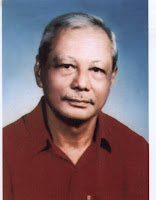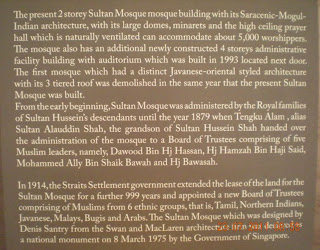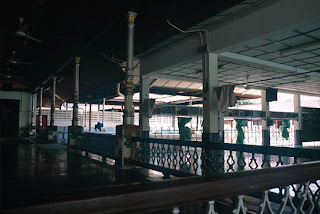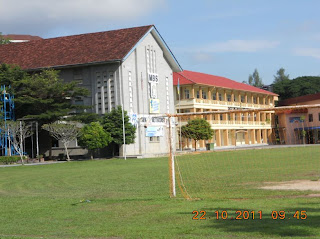This sad news is from Professor Baharuddin Aris about his father's demise, which I received today, and which made me cry:
"My dad, Aris bin Haji Abdul Aziz (nephew to Dr Hamzah), is among the contributors to Professor Faridah's book. He recently passed away in Johor Bahru on March 8, 2012."
His father, Haji Abdul Aziz bin Haji Md Taib married Hajjah Hasnah bt Orang Kaya Md Yassin bin Orang Kaya Md Salleh bin Orang Kaya Ringgit. Haji Abdul Aziz was the Penguasa Kastam Johor while Hajjah Hasnah was a Bugis homemaker.
His siblings were: Haji Junid (deceased), Hajjah Mariam (deceased), Md Yassin, Hajjah Maimunah, (Aris) and Hajjah Halimah.
 |
Grandfather, father and sons - three generations of Aris' family.
|
En Aris married Maznah bt Muhammad, who also worked with the Johor State Government. She too retired the same year at the age of 48. His wife had passed away in 1999 at the age of 63 (1936-1999).
 |
| With his beloved wife (both deceased). |
En Aris' two sons are Professor Dr Haji Baharuddin (UTM) and Ir Izaddin (Switzerland).
Professor Baharuddin is a Professor of Multimedia and Internet-based Learning at UTM Skudai in Johor. On 15 May 2001, he became the First Malaysian to be listed in the Who’s Who In Instructional Technology on the World Wide Web, verified by the Malaysia Book of Records.
Ir. Izaddin is a consultant engineer with a Swiss multinational based in Switzerland.
DRIVING DIRECTIONS
En Aris (then 74 years in 2009) had lived in his four-bedroom bungalow near Yayasan Pelajar Johor (YPJ) in Larkin Jaya, Johor Bahru.
To get to his house, take the North-South Highway to Kempas Baru and turn off into Jalan Langkasuka, the house is before the traffic lights.
DEMISE
En Aris passed away on 8 March 2012, aged 77. His death was informed by his son, Professor Baharuddin bin Aris on 25 April 2012.
His son Professor Baharuddin bin Aris has passed away.
CONTRIBUTION TO RESEARCH ON THE EARLY MALAY DOCTORS
En Aris was very helpful to this research. He was contacted through his son, Professor Baharuddin.
Dr Hamzah’s roots were informed by Encik Aris bin Abdul Aziz on 5-8 January 2008. He gave a detailed account of Dr Hamzah's life.
Among other things, Encik Aris explained many things in Johor history. He explained about Malay marriages and the meaning of salin tikar. He also explained the meaning of the term anak Muar. He emphasized the greatness of the Malay people especially those from Muar whom he knew, their families, links and roots.
He contributed in writing and drawing up the various family trees and added so much detail. He supplied the very important bulletin, Jendela Selatan, which was otherwise difficult to obtain. He supplied many photos for the author to keep.
He also checked several drafts of Dr Hamzah's biography and would immediately call the author if he noticed any inconsistency, error or something was wrongly worded. He carefully checked all the details in Dr Hamzah's biography till he was happy with it. He was happy in the end and thanked the author for writing about his favourite uncle.
We will certainly miss him as he was a great contributor to this research since 2008.
We convey our condolences (ucapan takziah) to his two sons and gift them the reward (pahala) for reading Al-Fatihah. Please read Al-Fatihah for him. May he attain Husnul Khatimah and may his soul be placed among the soleheens and all the great people in Islam. In sya Allah.
Prof Faridah
3.09 p.m.
25 April 2012
USM in Kelantan
------------------------------------------
"Obituary: Aris bin Abdul Aziz"
6 Comments
1 – 6 of 6
Anonymous Amirul Asyraf said...
Wow finally I found the pic of my "great-great grandfather" Haji mohd taib bin talib since his son Abdul Hamid was my great-grandfather my father told me he used to call him Encik Lelaki.
9 October 2014 at 11:27
Blogger Faridah said...
Amirul Asyraf,
I'm glad you found your great-great-grandfather's photo here. TQ for sharing information on your gggrandfather and ggrandfather.
9 December 2014 at 16:22
Blogger Aksara Dot Com said...
Truly to Allah we belong and truly to Him we shall return.
May the soul of the late Aris Bin Abdul Aziz be placed amongst the righteous. His father, Abdul Aziz and my grandfather, Abdul Hamid, are siblings.
Al-Fatihah....
11 September 2016 at 07:00
Blogger Faridah said...
TQ, Askara Dot Com.
TQ for informing that they were sibs.
18 September 2016 at 11:21
Blogger Aksara Dot Com said...
Blogger Faridah said...
=====================================
OBITUARY #2
Professor Baharuddin bin Aris
On Blogger since October 2008
My blogs:
Prof bba weblog
The Early Malay Doctors
Profile views - 1886
 |
Professor Baharuddin bin Aris, pic from his Facebook.
|
Introduction
A graduate from Iowa State University (BSc) and Robert Gordon University (PhD), he had vast experience in the field of Multimedia and Internet-based learning. Apart from being an administrator for more than a decade, he had published extensively based on his research & development (R&D) of Multimedia and Internet-based learning. His books in 2008 included: Learning Objects and Generative Learning for Higher Order Thinking - a chapter in a “Handbook of Research on Learning Design and Learning Objects: Issues, Applications and Technologies” & “How to Design Multimedia Web Applications: Theory Into Practice”. Among his research areas included: Computer Science Education – Teaching & Learning Computer Science, IT & Multimedia Technology based on Pedagogy/Andragogy Using ICT. He is also active as an editorial board member for journals such as JITE, IJCA, IJIKM, IJEL & AJET.
Demise
 |
Professor Baharuddin bin Aris, deceased 7 April 2019.
Portrait via Andi Asrifan on Facebook. |
 |
| Tribute from UTM |
He was former Dean of the Faculty of Education at UTM, Skudai, Johor. He passed away on 7 April 2019 at Hospital Serdang at 5.40 a.m. He was 61 years old (1958-2019).
His remains (jenazah) was washed and cloaked (kafankan) at 8:30 a.m. at Hospital Serdang.
His remains were then brought to Surau Al Firdaus for Solat Jenazah at 10-10.30 a.m. He was laid to rest at Tanah Perkuburan Kg Desa Putra.
Prof Baharuddin was a Bugis of Wajo ancestry.
His residence was No. 32 Jalan Saujana 1/13.
His home was at Sg Mehrab in Kajang.
His widow is Dr Maizahura.
Prof. Faridah Abdul Rashid
Author
The Early Malay Doctors
10:58 p.m.
13 September 2021
------------------------------------------------------------------
Bugis Wajo Ancestry
The Bugis Wajo comes from the Celebes or Sulawesei.
Bugis Wago Ancestry.
Haji Pagak bin Daeng Amri was Bugis Wajo.
He was the father was Dr S bin Haji Pago.

































































